Studying the Role of the Degree of Acceptance of Other Cultures in a Multicultural Educational Environment
Abstract
The number of people in the world trying to get education abroad reaches 5 million. The formation of psychological security of environment in educational process is a necessary condition of getting quality education and personal development of a student. The degree of reception of another culture in intercultural education is a bases for secure and effective communication for all students. The present article deals with the problem of adaptation of foreign students and their integration into multicultural educational environment through acceptance of another culture. The role of local international university students is considered and their attitude and role in the process of adaptation. The results of research on the basis of author’s questionnaire “Acceptance of another Culture” are presented. The major factors of “Acceptance of another Culture” were studied. The comparative analysis has been done which include the factors of constructive adaptation processes among Russian students and those who immigrated to England.
Keywords: Multicultural educational, socio-cultural adaptation of foreign students, strategies of adaptation, factors of successful adaptation, maladaptive factors of educational process, psycho-correctional adaptation methods in education
Introduction
The UNESCO Institute for Statistics (UIS) is the statistical branch of the United Nations
Educational, Scientific and Cultural Organization. The number of students going abroad in order to get
education reaches the figure of 5 million and has the tendency for stable growth. The formation of
psychologically safe supporting environment in educational process is topical and necessary condition
for receiving quality education and personal development of students. The study of peculiarities of
socio-psychological adaptation of international students with consideration of ethnic mentality and
selection of methods of research are of great current importance now (Drozhzhina D.S., 2013 &
Kakimzhanov M.K., 2015). Psychological safety is an important state of educational environment, being free from manifestations of psychological violence in interrelations, provides satisfaction of
needs of personal and confidential communication, creates reference significance of environment and
provides psychological health needed for participants (Amirova O.K. & Lebedeva N.V., 2015) . The
integration of foreign students and their dialogue in multicultural educational environment is
considerably defined by the readiness of “local students” to accept them into their environment. In
order to study this matter we elaborated our own questionnaire “Acceptance of Another Culture”. Of
great importance, in our view, is to study intercultural communication processes in multicultural
education (Bagramova N.V., 2008, 2009,2012). Some scholars, e.g. I.A. Baeva, believe that
communication of participants of training and educational process present educational environment,
socially organized favorable psychological and pedagogical conditions for its realization, “give birth”
to psychological safety of educational environment (Baeva I.A., 2002). The category of psychological
safety is defined by the authors in three aspects: communicative, interactive and perceptive
competence.
The situation of migration is transformational for every individual. Several authors have noted
increasing levels of creativity while been in multicultural environment (Maddux, WW, 2010). External
cultural pressure from environment leads to the need for restructuring and development of dynamic
components of personality. In order for students to be able to fully express themselves, it is necessary
to provide them with the appropriate climate and facilitate the process of integration into the society.
The emotional involvement of students in the learning process plays a major role in this (Ming Ming
Chiu, 2011), as well as the attitude of foreign students to fellow students (Junious, DL, 2010). The
difference between the cultures forms "necessary zones for development". In a stable situation, with
absence of significant cultural differences, the selection is carried out in preference to the side of
recognizable factors that may inhibit personal development and inter-group interaction, creating a
comfort zone.
The set of task
The task of research is the role of the degree of acceptance of other cultures in a multicultural
educational environment.
Questions of research
Hypotheses: We may guess the influence of a degree of acceptance of another culture on the
constructive and destructive character or processes of flow of sociocultural adaptation of students; the
effectiveness of adaptation is greatly defined by readiness of “local students” to accept them to their
environment.
The goal of research
The goal of the given work is research of degree of acceptance in the intercultural communication
with the local students and foreign students, and building up of an effective dialogue in multicultural
educational environment.
Method of research
We have studied the degree of acceptance by students of another culture in multicultural
environment. In the communicative, interactive and perceptive competence of students, we evaluate
our work through study of the degree of acceptance of another culture. The technique of acceptance of
another culture is elaborated. Technique of research: author s questionnaire «Acceptance of Another
Culture»; composed of 30 questions. Quesfions are connected with the choice of preferences in artistic
activities of writers, artists, composers, actors, cuisine, radio shows. Selection was done among
Russian, English figures, and also it was proposed to give personal option of an answer. The choice of
place, culture, environment of education of children, knowledge of languages, attitude to mixed
marriage is a defining and international factor in degree of another culture. Questions connected with
other identity characterize the degree of psychological maturity, stability, consciousness of degree of
acceptance of own culture.
Respondents: Russian students of KFU and students-temporary migrants who study in
London. Age -20. Political and cultural environment of KFU is great interest because students from
81 countries study in the university. Their number is 3200. Experimental part of the study was done on
the bases of Kazan Federal University and on the bases of «Russian - London » society (London, GB).
Results of research;
The questionnaire was tested. Studies are done on the components «comprising acceptance of
another culture» which influence formation of constructive accepted line of conduct which contribute
to integration of foreign students into multicultural education and constructive interaction, and also the
factors of destructive character. Exponential results during interaction with another culture are:
language knowledge (12), its application (13, 14, 16); interaction with representatives of other nation
(22, 24,30); plans for future (17, 18); processes of adaptation (19, 20, 21); interfluence (22); motivation
(25); financial situation. See the tab. 1.
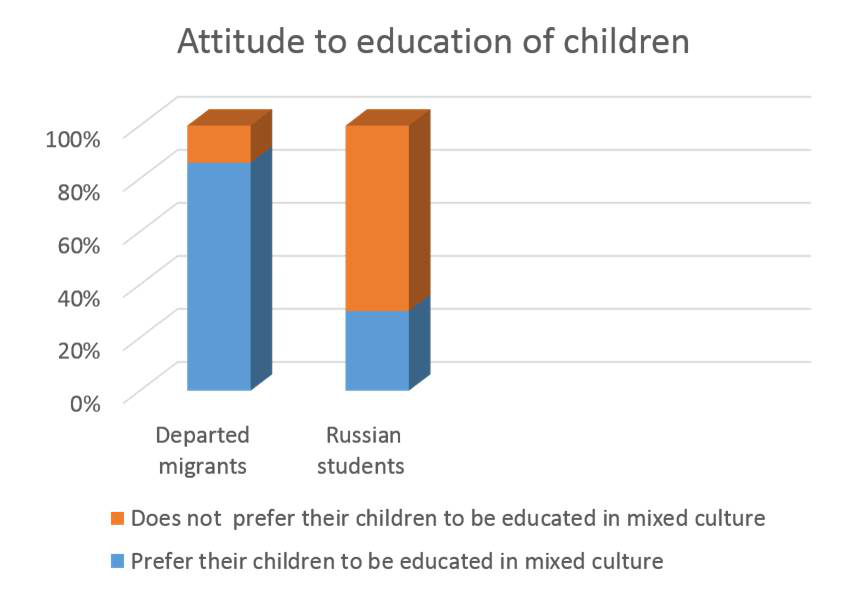
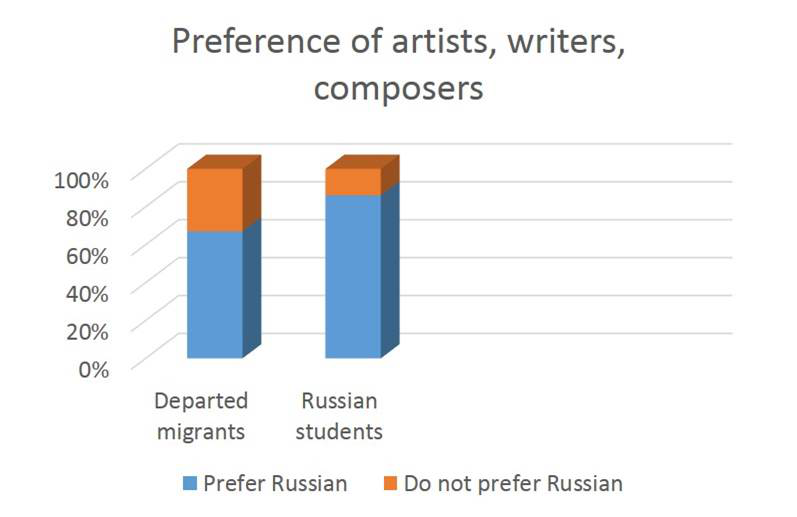
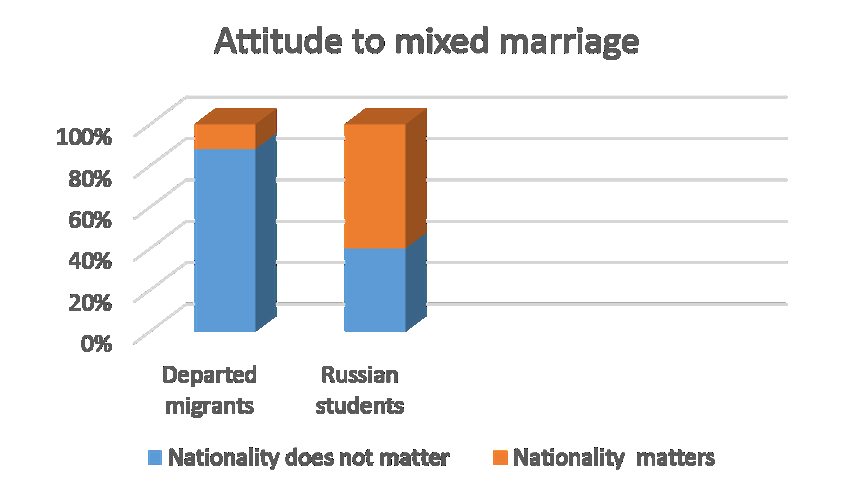
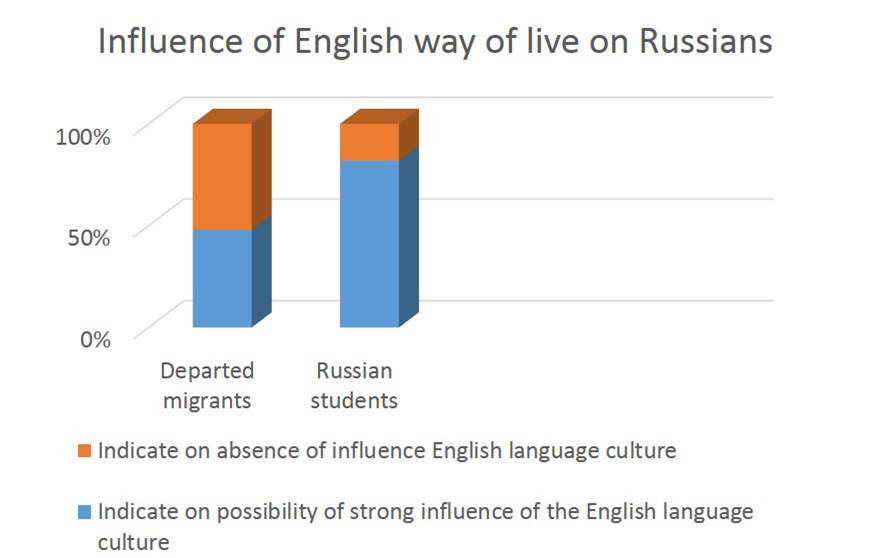
Analysis of paragraphs 29 and 30 of the questionnaire allows you to assess the nature of the
acculturation strategies chosen by migrants (Tab.2). Qualitative analysis of paragraphs of the author's
questionnaire "AAC" showed that students, immigrants prefer Russian artists, writers, composers, but
in a smaller percentage compared to the first year of residence (67 % of immigrants to 86% of
Russians). Sociocultural adaptation of immigrants is realized by the choice of acculturation strategies
according to the type of integration (40%) and assimilation (60 %) − of immigrant women, and the
assimilation (60%) and separation (40%) – of immigrant men (pic.5).
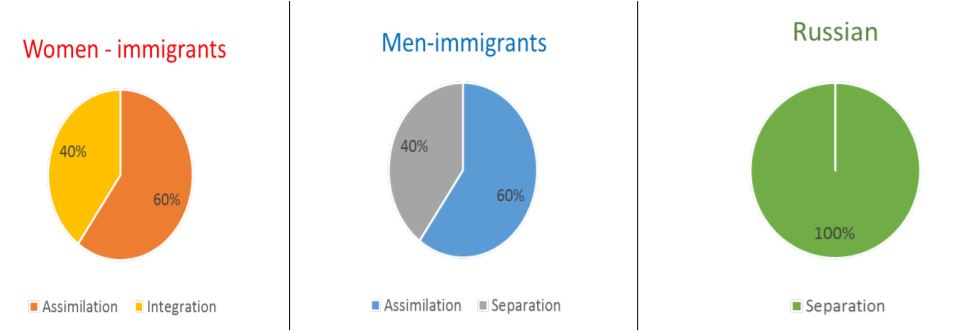
Despite the fact that, as shown by the conversation with student immigrants the decision to emigrate
was taken by them not spontaneously, the way for immigrants were long enough (according to the
survey on average from 2 to 5 years) and they had sufficient time to familiarize themselves with the
culture of the country of entry and even agree with some of its requirements, but cultural distance,
however, was preserved. Russian students are at a stable situation in homeland while safeguarding the
native comfort zone (separation 100%) and that may complicate communication with other visitors and
hinder acceptance of foreigners.
Conclusions
Sociocultural adaptation of immigrants is realized by the choice of acculturation strategies
according to the type of integration and assimilation - of emigrant women, and the assimilation and
separation - of emigrant men. The situation of migration is transformational for the individual. External
cultural pressure of environment leads to the necessity of reformation and formation of dynamic
components of the personality.
Migrant women easily reach the degree of acceptance of another culture and 40% are integrated. In
case of Russian students, during stable situation at home, the choice in preferences is carried out in
direction of the recognizable, keeping the comfort zone that perhaps complicates communication with
newcomers, and hinders the acceptance of foreigners. Russian students, regardless of gender, built
intergroup interactions on separation type, saving separate groups of their ethnicity.
The multicultural environment is a developing and transforming factor for the personality of
students. Educational activities of group and individual type with the students by tutors with teachers,
aimed at increasing the adoption of a different cultural environment are necessary. Psychological help
to students in a multicultural environment should be provided in the development of the degree of
acceptance of the other in the educational cooperation, mutual development, readiness to help
international students integrate into a different environment, thereby greatly enhancing the efficiency
of the educational process. Integration processes increase psychological security and contributes to the
formation of a constructive course of action in a multicultural education. Strategy of separation of
Russian students indicates that there are unresolved conflicts, confusion of understanding, which
requires solution. The important point is the lack of marginal trends in collaboration, both among
migrants and Russians.
The arrangement of group and individual kind of educational activities are required with students,
tutors, teachers in order to increase the degree of acceptance of another culture. Integration processes
promote psychological safety and contribute to the formation of constructive behavior in a
multicultural learning process.
Psychological assistance to students in a multicultural environment should be provided in the
development of the degree of acceptance of another in educational interaction, development of mutual
support, readiness to help foreign students to integrate themselves into different environment that will
greatly enhance the effectiveness of the educational process. Competencies of a teacher in a
multicultural educational environment should include knowledge of cultural and psychological
characteristics of ethnic groups and ability to establish contact during communication.
Acknowledgements
I thank the participants of the project: "Londoners", Russian students and all those who helped in the collection of empirical material, organizers of «Russian London» and KFU coordinators for work with foreign students.
References
Amirov, O. K., Lebedeva, N. (2015). In. Features of social psychological adaptation of foreign students in the Pskov state university. Modern problems of education in the multicultural environment. On reports of international scientific conf., 23-24 April 2015. Vol. 2. Pskov. http://izd.pskgu.ru/projects/pgu/storage/conferences/2015-03.html (accessed 30.04.2016)
Bagramova, N. V. (2008) Communicative-interactive approach as a way to improve foreign language acquisition// proceedings of the XXXI all-Russian scientific-methodical conference of teachers and graduate students.Vol. 18, 3-6.
Bagramova, N.V. and others (2009). Problems of modern philology and linguistics: Collection of scientific works. SPb: Publishing house A. A. Herzen RGPU.
Bagramova, N. V. (2012) Linguistic personality from the standpoint of the theory of bilingualism.// The formation of bilingual identity on the basis of competence approach./Ed. by G. A. Baeva.- SPb.: St. Petersburg University Press, 2012, pp. 5-20./Ed. by G. A. Baeva.-St. Petersburg University Press, 2012, 5-20.
Baeva, I. A. (2002). Psychological security in education: Monograph. SPb.: Publishing house "SOYUZ",271.
Drozhina D. S. (2013) Study of adaptation of foreign students: a discussion of methodology // Universitas. Magazine about the life of universities. Volume 1. 3 N/ C 33-47 [Electronic resource] – access Mode. URL: https://universitas.hse.ru/
Junious, D.L. (2010). Stress and perceived faculty support among foreign-born baccalaureate nursing students. Journal of Nursing Education Volume 49, Issue 5, pp. 261-270.
Kakimzhanova, M. K. (2015). About some of the issues and methods of research of social adaptation of foreign students at the higher school of Kazakhstan//Materials of Republican scientific-theoretical conference "Seyfullin reading - 11: Youth and science", Vol. 1, part 3, 15-18.
The UNESCO Institute for Statistics (UIS) is the statistical branch of the United Nations Educational, Scientific and Cultural Organization http://www.uis.unesco.org/Education/Pages/international-student-flow-viz.aspx (accessed 10.05.2016)
Maddux, W. W. (2010). When in rome . . . learn why the romans do what they do: How multicultural learning experiences facilitate creativity. Personality and Social Psychology Bulletin Volume 36, Issue 6, June, 731-741.
Ming, Ming Chiu (2012). Immigrant Students’ Emotional and Cognitive Engagement at School: A Multilevel Analysis of Students in 41 countries. J Youth Adolescence DOI 10.1007/s10964-012-9763-x EMPIRICAL RESEARCH
Copyright information

This work is licensed under a Creative Commons Attribution-NonCommercial-NoDerivatives 4.0 International License.
About this article
Publication Date
20 July 2016
Article Doi
eBook ISBN
978-1-80296-011-2
Publisher
Future Academy
Volume
12
Print ISBN (optional)
-
Edition Number
1st Edition
Pages
1-451
Subjects
Teacher, teacher training, teaching skills, teaching techniques, organization of education, management of education, FLT, language, language teaching theory, language teaching methods
Cite this article as:
Latypova, E. (2016). Studying the Role of the Degree of Acceptance of Other Cultures in a Multicultural Educational Environment. In R. Valeeva (Ed.), Teacher Education - IFTE 2016, vol 12. European Proceedings of Social and Behavioural Sciences (pp. 103-108). Future Academy. https://doi.org/10.15405/epsbs.2016.07.17

